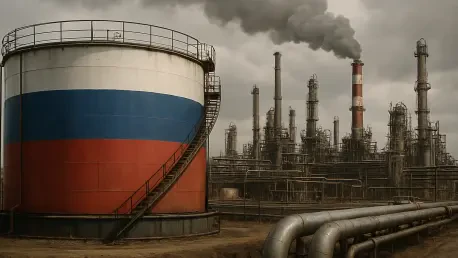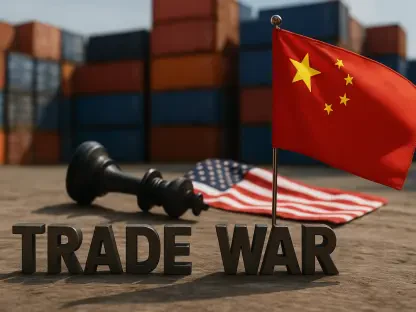What happens when a single economic policy could either cripple a war machine or ignite global chaos at the gas pump? President Donald Trump’s audacious plan to impose tariffs on nations buying Russian oil—think powerhouses like India and China—aims to strangle Russia’s funding for the conflict in Ukraine, making it a daring geopolitical chess move that could redefine energy markets and international alliances in one fell swoop. The question looms: can this high-stakes gamble bring peace, or will it backfire spectacularly?
A Bold Strategy with Sky-High Risks
This tariff initiative stands as one of the most aggressive foreign policy tools deployed to pressure Russia into a resolution in Ukraine. By targeting countries that fuel Russia’s economy through oil purchases, Trump seeks to cut off a vital lifeline for Moscow’s military efforts. The potential to disrupt billions in revenue is real, but so is the danger of alienating key global partners and triggering economic fallout that could hit American consumers hardest.
The scale of this decision reverberates far beyond mere trade disputes. With global energy supplies hanging in the balance, a misstep could send oil prices soaring, impacting everything from transportation costs to household budgets. The audacity of this approach lies in its attempt to force a diplomatic breakthrough through economic pain, but the tightrope walk between success and disaster has never been more precarious.
Why This Matters: War Funding Meets Oil Power
Russia’s ongoing conflict in Ukraine, now a prolonged struggle, hinges heavily on oil revenues that bankroll its military operations. As the world’s second-largest oil exporter, Russia has found eager buyers in nations like India and China, especially after Western sanctions reshaped trade dynamics. These countries have become critical to Moscow’s financial survival, stepping in to fill the gap left by European markets.
Trump’s secondary tariffs aim to sever this economic artery, targeting these buyers to choke Russia’s income stream. However, the consequences could ripple back to American shores, with potential spikes in fuel prices threatening to inflame inflation. With domestic economic challenges already mounting, including a softening housing market, the political cost of this strategy could weigh heavily on Trump’s support base as midterms approach.
The intersection of war, oil, and power underscores a critical tension. While the intent is to weaken Russia’s war chest, the global energy market’s interconnected nature means that any disruption risks punishing allies and adversaries alike. This policy’s significance lies in its potential to redraw geopolitical lines, but at what cost to stability remains an open question.
Unpacking the Tariff Mechanics and Fallout
The core of this strategy involves secondary tariffs that penalize countries for purchasing Russian oil, aiming to dry up Moscow’s war funding. A 25% tariff on Indian goods has already been implemented, with similar measures against China under consideration. This economic pressure seeks to force a shift in buying behavior, potentially slashing Russia’s oil revenue by significant margins.
Yet, the economic repercussions could be severe. Analysts from JP Morgan caution that if India, importing 1.7 million barrels per day, halts Russian oil purchases, global supply could drop by 2%. This might push Brent crude prices into the $80s per barrel or higher, reminiscent of the $130 spike seen in early conflict stages. Such a surge would fuel inflation worldwide, hitting U.S. consumers with higher costs at the pump and beyond.
Geopolitically, the tariffs strain ties with major powers. India’s role in pharmaceutical supplies and China’s dominance in critical mineral exports give them leverage to push back, potentially derailing broader U.S. trade goals. Domestically, Trump faces risks too—rising fuel costs amid weak job growth could erode voter confidence, even as he positions this as a resolute stand against Russian aggression.
Expert Voices Cast Doubt on Putin’s Reaction
Policy analysts express deep skepticism about the tariffs’ ability to alter Russian President Vladimir Putin’s course in Ukraine. Eugene Rumer of the Carnegie Endowment for International Peace starkly notes a “close to zero chance” of Putin conceding to a ceasefire under economic duress. This view stems from Putin’s track record of enduring sanctions without yielding on core strategic goals.
Brett Bruen, a former foreign policy adviser, reinforces this doubt, highlighting that while tariffs may inflict hardship, Putin’s adeptness at evading economic penalties suggests little impact on his war decisions. Cullen Hendrix from the Peterson Institute adds a nuanced take, suggesting that Trump could gain voter appeal by framing this as a tough stance, yet warns of “massive downside risks” to both the economy and diplomacy. These insights paint a grim reality: bold as the policy may be, its leverage over Moscow appears limited.
The consensus among experts points to a disconnect between economic tools and political outcomes in this context. Russia’s resilience, coupled with Putin’s apparent indifference to domestic economic pain, raises fundamental questions about whether financial pressure alone can shift the battlefield dynamics. This skepticism forms a critical lens through which to evaluate the tariff gamble.
Navigating the Perils: Possible Paths Forward
Given the inherent risks of this tariff strategy, identifying ways to mitigate fallout becomes essential for policymakers. One approach involves preparing for oil price volatility by bolstering domestic energy reserves or securing alternative supply agreements with non-Russian exporters. While U.S. producers may struggle to fully offset shortages, proactive steps could cushion the blow of potential market shocks.
Diplomatic balance is equally vital. Engaging India and China through targeted negotiations, rather than punitive tariffs alone, could preserve access to critical supplies like pharmaceuticals and minerals. Crafting trade deals that prioritize mutual benefits over confrontation might lessen the strain on these pivotal relationships, maintaining strategic alliances amid the push against Russia.
Finally, clear communication with the American public is crucial. Trump’s administration must articulate why this economic risk ties directly to supporting Ukraine, while outlining safeguards against domestic impacts. Simultaneously, exploring direct talks with Putin, however slim the odds, could offer a complementary diplomatic channel. These combined efforts provide a framework to manage consequences while sustaining pressure, recognizing that peace in Ukraine demands more than economic measures alone.
Reflecting on a Risky Gambit
Looking back, Trump’s tariff policy on Russian oil buyers emerged as a daring yet divisive attempt to influence an entrenched conflict. The economic strain on Russia was undeniable, yet the collateral damage—spiking oil prices and frayed alliances—often overshadowed the intended impact. Each calculated move revealed the fragile balance between punishing an adversary and protecting global stability.
The path ahead demanded innovative solutions, from securing energy alternatives to rebuilding trust with key trade partners. Policymakers had to prioritize diplomatic outreach alongside economic tactics, ensuring that the pursuit of peace did not ignite broader unrest. Learning from this chapter, the focus shifted toward crafting strategies that paired pressure with dialogue, aiming for resolutions that endured beyond immediate crises.









